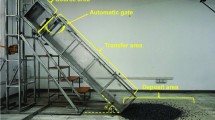Abstract
In this paper, the motion and acceleration process, as well as the mechanism of a high speed and long run landslide are investigated by adopting high speed ring shear test and taking the landslide occurred at Yigong River in Bomi, Tibet on April 9, 2000 as the background. According to the motion characteristics of high-speed and long distance motion landside, the mechanism is studied under different conditions such as shear speed, consolidated drained and consolidated undrained status. Results show that high speed shearing process hinders and delays the dissipation of pore pressure, and drives pore water migrating to shear zone slowly. Both of water content and fine particle content at shear zone are obviously higher than those in other layers; and soil liquefaction occurs at shear zone in the saturated consolidated undrained ring shear tests. The effective internal friction angle of the consolidated undrained soil is much lower than that of the consolidated drained soil under ring shearing. The results also indicate that the shearing speed affecting the strength of soil to some extent. The higher the ring shearing speed is, the lower the strength of soil is. This investigation provides a preliminary interpretation of the mechanism of the motion and acceleration process of the Yigong landslide, occurred in Tibet in 2000.
Similar content being viewed by others
References
SassaK (1984) The mechanism starting liquefied landslides and debris flows. Proceedings of 4th International Symposium on Landslides, Toronto, Canada. Vol 2, pp 349–354.
Iverson RM, Reid ME, LaHusen RG (1997) Debris-flow mobilization from landslides. Annual Review of Earth and Planetary Sciences 25: 85–138.
SassaK (1998b) Geotechnical model for the motion of landslides. Special Lecture of 5th International Symposium on Landslides, Landslides 1: 37–55.
Liu GQ, Lu XY (2000) Analysis on the formation of the huge landslide and debris flow in Yigong, Tibet. Tibet’s Science and Technology 4: 15–17. (In Chinese)
Yin YP (2000) Study on disaster reduction and character of the high speed large scale landslide in Bomi, Yigong, Tibet. Hydrogeology and Engineering Geology 4: 8–11. (In Chinese)
Chai HJ, Wang ST, Xu Q, et al. (2001) Numerical simulation on overall process of Yigong slump at Bomi, Tibet. Journal of Geological Hazards and Environment Preservation 12(2): 1–3, 82. (In Chinese)
Liu GQ, Lu XY, LI Y (2001) Analysis of collapse landslide and mud-rock flow deposit break in Tibet Yigong. Water resources & Hydropower of Northeast 19(7): 26–27. (In Chinese)
Ren JW, Shan XJ, Shen J, et al. (2001) Geological characteristics and kinematics of the rock fall-landslide in Yigong, southeastern Tibet. Geological Review 47(6): 642–647. (In Chinese)
Wang ZH, Lu JT (2001) Understand Yigong Landslide in Tibet Based on the Satellite Image. Journal of Remote Sensing 5(4): 312–316. (In Chinese)
Zhu BQ, Nie YP (2001) Using satellite remotely sensed data to monitor Yigong tremendous high-speed landslide. Journal of natural disasters 10(3): 103–107. (In Chinese)
Liu W (2002) Study on the characteristics of huge scale super high speed long distance landslide chain in Yigong, Tibet. The Chinese Journal of Geological Hazard and Control 13(3): 9–18. (In Chinese)
Lu JT, Wang ZH, Zhou HH (2002) A Tentative Discussion on the Monitoring of the Yigong Landslide blocked Lake with Satellite Remote Sensing Technique. Acta Geoscientia Sinica 23(4): 363–368. (In Chinese)
Wang FW, Sassa K, Wang GH (2002) Mechanism of a longrunout landslide triggered by the August 1998 heavy rainfall in Fukushima Prefecture, Japan. Engineering Geology 63: 69–185. DOI: 10.1016/S0013-7952(01)00080-1
Guo GM (2005) New views on the huge landslide in Yigong, Tibet. Earth Science Frontiers 12(3): 276–279. (In Chinese)
Wang FW (2005) Fluidization mechanisms and motion simulation on flow slides triggered by earthquake and rainfall. Chinese Journal Rock Mechanics and Engineering 24(10): 1654–1661. (In English of Chinese Journal)
Chen GQ, Huang RQ, XU Q, et al. (2012) Prevention of the Natural Landslide Disaster Based on the Deformation Management Level. Disaster Advances 5(4): 1719–1724.
Chen GQ, Huang RQ, XU Q, et al. (2013) Progressive of the Using the Local Dynamic Strength Reduction Method. Journal of Mountain Science 10(4): 532–540. DOI: 10.1007/s11629-013-2367-4
Author information
Authors and Affiliations
Corresponding author
Additional information
http://orcid.org/0000-0003-2475-2357
http://orcid.org/0000-0001-6910-3647
http://orcid.org/0000-0002-0014-6937
http://orcid.org/0000-0002-5912-7095
Rights and permissions
About this article
Cite this article
Hu, Mj., Pan, Hl., Zhu, Cq. et al. High-speed ring shear tests to study the motion and acceleration processes of the Yingong landslide. J. Mt. Sci. 12, 1534–1541 (2015). https://doi.org/10.1007/s11629-014-3059-4
Received:
Accepted:
Published:
Issue Date:
DOI: https://doi.org/10.1007/s11629-014-3059-4




